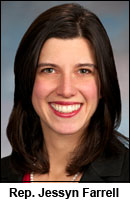OPINION
State should follow Seattle’s lead, increase minimum wage
By JOHN BURBANK
(July 17, 2014) — If you are awake at 4 a.m. these days, you will notice the sky is already getting a little light. As you go to sleep at 11 p.m., you can still make out some light in the night sky. We are at the beginning of our summer in the Northwest, and it is a great time to celebrate being alive in this gift of nature and weather.
Last weekend more than 10,000 bicyclists rode 200-plus miles from Seattle to Portland. Next month another 2,000 will bicycle from Seattle, through Snohomish, up the Centennial Trial, to Lake Stevens, and eventually to Bellingham and onto Vancouver. For us more ordinary people, we are out gardening, hiking in the mountains or walking in the neighborhood, bicycling to work, or just enjoying these days of sun, warmth, and low humidity.
I had a couple of days in Washington, D.C. this week. No wonder people are grumpy there. Getting out of the airport you walk into a virtual hot mist of humidity. Makes you want to turn around and go right home. This actually makes sense, not just for the weather, but also for the politics. Gridlock is getting us nowhere in this country, so it is up to us in the states and cities to make progress as best as we can.
Here’s one approach to chew on as we run down the last half of this year and get ready for 2015.
 A lot of people watched the Seattle process for a $15 minimum wage. The result was good, but didn’t do a whole lot for minimum wage workers in Everett, Marysville, and pretty much anywhere outside of Seattle. But at the same time the $15 minimum wage was advancing in Seattle, state legislators were putting together a proposal to increase the minimum wage across the state. That is unfinished business, to be completed next year.
A lot of people watched the Seattle process for a $15 minimum wage. The result was good, but didn’t do a whole lot for minimum wage workers in Everett, Marysville, and pretty much anywhere outside of Seattle. But at the same time the $15 minimum wage was advancing in Seattle, state legislators were putting together a proposal to increase the minimum wage across the state. That is unfinished business, to be completed next year.
The proposal is pretty simple. Over three years, the minimum wage increases, first to $10, then to $11, and then to $12. It is an actual minimum wage, covering all workers in all industries. It enables workers to earn a minimum wage that is close to what that wage brought in 1968 in terms of real purchasing power (right now our minimum wage is only about 85% of its 1968 value). This $12 minimum wage would still be well below what it would have been if it had kept up with productivity increases since 1968. (If it had kept up, it would be at about $18 an hour.) But it is a lot better — two and a half dollars better — than our current standard.
Increasing the minimum wage is good for our economy. There are 300,000 minimum wage workers in Washington. Add $1 an hour to their wages, and they receive and spend over $600 million of new money in purchases for goods and services. That means Main Street businesses in all our communities benefit from more customers at the same time that they gain more productive and loyal workers. That new spending also adds to tax receipts, to pay for things like education.
 Thirty-two state representatives joined the primary sponsor, Rep. Jessyn Farrell (D-Seattle), in this legislative effort for a better minimum wage. But no Republican legislators — not one — sponsored this minimum wage increase. All Republican state representatives in the Labor and Commerce Committee opposed this increase.
Thirty-two state representatives joined the primary sponsor, Rep. Jessyn Farrell (D-Seattle), in this legislative effort for a better minimum wage. But no Republican legislators — not one — sponsored this minimum wage increase. All Republican state representatives in the Labor and Commerce Committee opposed this increase.
The last time the Legislature refused to increase the minimum wage was in 1998. The people countermanded them, passing Initiative 688 by a two-to-one margin and increased the minimum wage while tying it to inflation.
Let’s hope next year legislators see the wisdom of increasing the minimum wage. It is simply a needed update to move closer to a wage that reflects the real value of work.
 John Burbank is the executive director and founder of the Economic Opportunity Institute in Seattle. John can be reached at john@eoionline.org.
John Burbank is the executive director and founder of the Economic Opportunity Institute in Seattle. John can be reached at john@eoionline.org.





